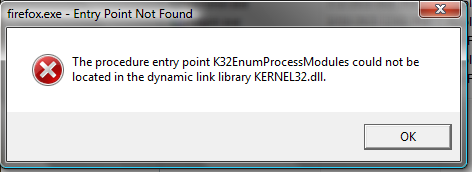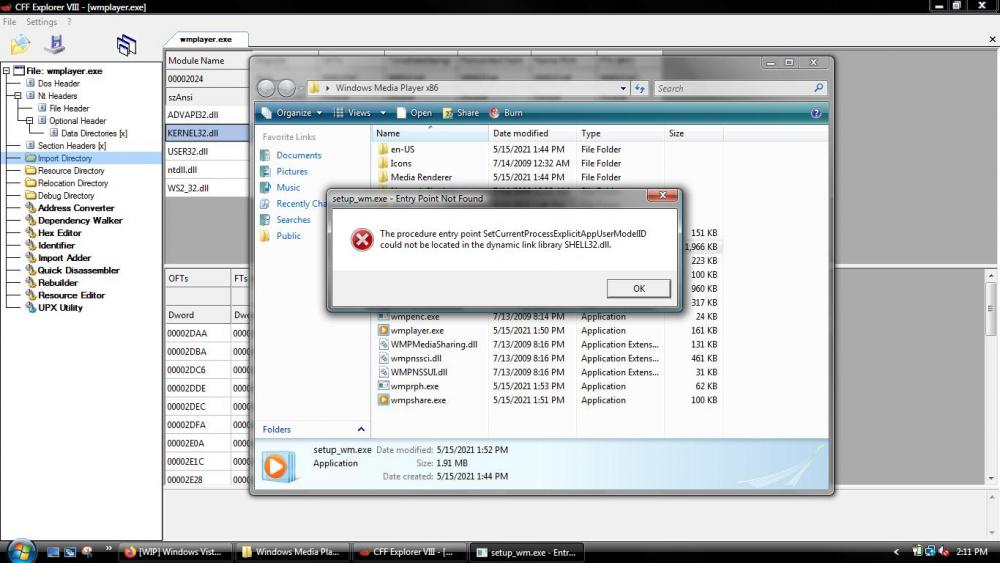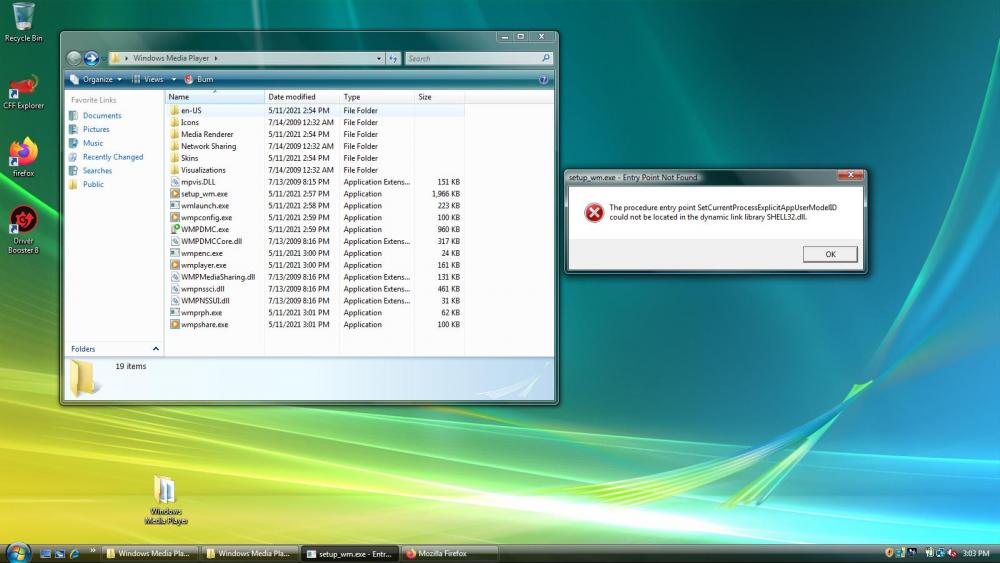
Jakob99
MemberContent Type
Profiles
Forums
Events
Everything posted by Jakob99
-
I installed the May 2021 Extended Kernel and modded the Firefox 86.0.1.7739 exe files, but when I open firefox.exe, I get The procedure entry point K32EnumProcessModules could not be located in the dynamic link library KERNEL32.dll. I know Extended Kernel May 2021 is working as Windows 7's Paint and Calculator work just fine. I am wanting to use Firefox 86 as Firefox 89+ has been known to have rendering issues in Vista. I will include an image of the error below. Any help on this problem is greatly appreciated!
-
Not yet. Not sure if that would even work with Vista. EDIT: I just posted here https://forums.mydigitallife.net/threads/uefiseven-easily-boot-windows-7-on-uefi-class-3-devices.82137/ asking if this would work with Vista. Waiting for a reply.
-
What I was trying to do is Install Windows Vista to UEFI mode using Windows 10's installer. Basically, I removed Windows 10's install.wim and replaced it with Vista's so when you ran the USB, it would load Windows 10's setup, but install Windows Vista instead of 10. Unfortunately, this did not work in getting Vista to load on my laptop's UEFI mode (It was bought in 2019).
-
Does anyone know if it is possible to install Windows Vista to a USB HDD/SSD and run it from there? I know Windows 7 works with it provided you are using USB 2.0 ports (trying to use USB 3.0 produces an Inaccessible Boot Device Error) as does 8 and later (which does support USB 3.0 using this configuration). I have tried installing Vista to a USB HDD using Rufus' Windows To Go feature (only available when running the program on 8 and later), but got a blue screen with Inaccessible Boot Device, even on laptops with USB 2.0 ports. Any help would be greatly appreciated!
-
I have a solution that may work. Burn a Windows 10 ISO as UEFI to a USB using Rufus or similar and then replace 10's Install.EFD (or whatever its extension is) with Vista's Install.wim. I'm gonna try this out and see what happens. EDIT: This did not work. The installer loaded up, I could manage the partitions (and I was indeed able to create more than 4), and let it do the initial installation (Expanding Windows Files), but after restart, I got the black screen @burd got. There has to be a way to get it to work. We could wait until @win32 adds Windows 7 driver support, but I am not sure if DISM Command Prompt supports installing Windows Vista through it (I tried to use 10's DISM to merge drivers into Vista, but it told me that DISM did not support Vista installations), and not a lot of people would want to do that. They'd rather have a simpler way to install Vista on UEFI, especially if they want a penta-boot (5 OSes).
-
As long as you can get 7 drivers to work on Vista, I'll be happy! The one good Vista laptop that I was using for the Extended Kernel broke due to my stupidity. Started to make a weird noise and one of the hinges was wonky, so I took it all apart to investigate, but broke the laptop completely. Luckily, I have one other laptop from 2010 that can run this. Also, has anyone investigated running Windows Vista in UEFI mode on newer laptops? I take it it in order to get it to work, we would need to disable the Basic Display Driver (which would result in the loss of safe mode and Blue Screen of Deaths until the Basic Adapter is reenabled after installation) and slipstream a compatible Windows 7 exclusive graphics driver into the ISO. From what I have heard from people trying to get Windows 7 working on certain models of the Acer Spin 5 (which is exclusively UEFI and has no Legacy mode) is that when using a 7 ISO formatted in UEFI mode, it freezes due to the Basic Display Adapter not supporting the revisions made to UEFI since Windows 8's release (It should be noted Windows 8 and later do not encounter this issue) and thus requires the Basic Display Adapter to be disabled and a graphics driver to be slipstreamed. Since 7 suffers from this, I take it Vista will too. I only ask this as under UEFI, you can have more than 4 partitions, and I want to setup a multi-boot of Windows Vista, 7, 8.1, 10, and 11 on my Acer Aspire A315-21 (when the Extended Kernel is improved to feature 7 driver support of course). I should also note that this problem is not caused by a specific USB creation tool such as Rufus. I also don't think much can be done about modern UEFI and Vista support until the 7 driver support debuts, but maybe there is somewhere we can start research. And I also think that getting the Basic Display Adapter back after Vista installation should be a priority as well. Without that, you lose two key features: Safe Mode and BSOD's (without those, we wouldn't be able to properly report it to @win32). Technically, Safe Mode still loads and BSOD's still get shown, you just can't see them as they will display a black screen. You could rely on a third party program that writes the content of the BSOD to a text file and be just fine, however, if you need safe mode, you are sol. Not sure if sharing this link is allowed, but if anyone wants more info on this issue, you can view the whole overview of it here http://forum.notebookreview.com/threads/guide-how-to-install-windows-7-x64-on-acer-spin-5-laptop.829379/ (This is for Windows 7, but can most likely be converted to Vista).
-
NTOSKRNL Emu_Extender for Windows XP/2003
Jakob99 replied to Mov AX, 0xDEAD's topic in Pinned Topics regarding Windows XP
Is there a video detailing this, or is someone willing to make one? Most of the directions are hard to follow. -
This did not work with my Hynix HBG4e eMMC drive. When I loaded the driver from the Windows installation media, it would not return any drives.
-
All of Windows Vista's stock applications are just XP's with Aero interface. 7 fixed this, but most of them still felt a little out of place with the Windows 8-esk ribbon, which was first seen in Office 2007.
-
There is an easier option for this. If your laptop still has a CD drive, use that, but if it does not, then you are still not out of luck. Instead, you can create a bootable Mini Windows 10 to a USB. This is the successor of sorts to Hiren's Mini XP. You can extract the ISO to a folder using 7Zip by right clicking it, hovering over 7Zip and opening it. You can then manually install Vista to your laptop using DISM command from within Mini Windows 10. Not sure if this is the same as what was mentioned above, but you could put the drive into another laptop, start the installation process from there, and the once it restarts for the first time, boot into the BIOS instead of letting setup continue, shut down the laptop via the power button, pop the drive out, and then put it in the newer laptop. Afterwards, it should start setting up the devices and finish setup. You do have an impasse in trying to copy files over if you don't have any 2.0 ports, but if you reboot into the Mini Windows 10, you can use it to copy over custom made USB 3.0 Windows Vista drivers, which you can find in this forum, or there is an ISO somewhere that has them already built-in, which means USB will already be working once setup is finished (they will not work during setup as it does not like unsigned drivers. It will warn you about the unsigned drivers later on, but you can just click "Install this driver anyway")
-
So nothing had to be edited? Interesting.
-
Interesting. What did you have to do to get setup_wm.exe to at least show that.
-
Windows Media Player has stopped working. Windows is checking for a solution to the problem. That's what happens whenwmplayer.exe is opened What do you get when you open setup_wm.exe?
-
My bad. I tried it using files from Windows 7 SP1 with all the updates and got this. If we can fix that error, it may work.
-
https://www.techmixer.com/download-windows-media-player-12-for-vista/ Check this out. WMP 12 works with Vista. Extended Kernel not needed.
-
NTOSKRNL Emu_Extender for Windows XP/2003
Jakob99 replied to Mov AX, 0xDEAD's topic in Pinned Topics regarding Windows XP
Ah. Hopefully that comes soon. -
Sorry for double post, but Facebook Live videos are a fail with the very latest Firefox on Vista. Not sure if these specifically have been mentioned. I know Youtube has, but not sure about Facebook, specifically Facebook Live videos.
-
NTOSKRNL Emu_Extender for Windows XP/2003
Jakob99 replied to Mov AX, 0xDEAD's topic in Pinned Topics regarding Windows XP
That is probably trivial right now. I'm waiting for the AMD Radeon R4 98E4 Stoney to work with Vista, which again is probably trivial. Also, I have a question. How do I apply these steps to Windows Vista x64 with @win32's Extended Kernel? Also, could someone make either a video or a picture tutorial on what to do? Some of the steps are a tad confusing and I feel having one of those to accompany this would help greatly. -
Does anyone know if this method will work with the Extended Kernel? I take it that it will, but just want to make sure.
-
NTOSKRNL Emu_Extender for Windows XP/2003
Jakob99 replied to Mov AX, 0xDEAD's topic in Pinned Topics regarding Windows XP
I have an Acer Aspire A315-21 with AMD Radeon R4 98E4 Stoney graphics card. Windows Vista can be installed, but graphics do not install. The graphics card has support for 7, 8.1, and 10. Would this method work in getting the graphics driver (and subsequently Aero) working under Vista? I will attach the 7355312.inf (NOTE: There is a 6.0 section at the very bottom that is blank. Filling this in with the graphics card info from the Windows 7 section and manually installing the file with Have Disk does not work) C7355312.inf -
I tried to run Windows Media Player 12 (extracted from Program Files from a Windows 7 installation I am using) and got this error to pop up after running setup_wm.exe: The procedure entry point SetCurrentProcessExplicitAppUserModelID could not be located in the dynamic link library SHELL32.dll. And I did open each exe file in CFF Explorer and changed all three instances of 6.1 to 6.0. After closing the error box, it then tells me that Media Player has stopped working.
-
He's probably really busy right now. I'm waiting for Windows 7+ drivers to work with this. I have an Acer Aspire A315-21-63F1 with AMD Radeon R4 Graphics (which does support 7 and 8.1 in addition to 10).
-
AMD Radeon R4 works with Windows Vista. I got it successfully installed on my Acer Aspire A315-21 by plugging in the Vista USB to a 2.0 port. Can't seem to get the Windows 7 Radeon R4 graphics driver working under Vista. It does have an empty 6.0 section at the bottom if anyone wants to try and get them working. Vista also works on my HP-f233wm. Had to install it through CD drive though USB was functional after the install was finished thanks to a generic USB driver someone built for it. This did not suffer the bug that affects Haswell and later. This looks like it uses an Intel Cherry Hill Celeron N3050 processor. Again, no clue on how to get the Intel Graphics working for this processor under Vista. 7 and later work just fine. If anyone wants to try it, be my guest. I should note that if the laptop comes with Realtek Ethernet, there are still Vista drivers for it if you google Realtek insert driver name here Ethernet.
- 41 replies
-
- Compatible
- Windows Vista
-
(and 1 more)
Tagged with:
-
Sorry for the triple post, but does anyone have a Windows 2000 driver for this: nVidia Quadro FX370M, Quadro NVS 160M, Quadro NVS160M, Quadro FX 770M, v.6.14.11.7607, A01. This one supports XP, but it does not work with 2000 and I can't seem to fine one that works with 2000. Thanks in advanced for your guys' help.
-
Alright. I rid of the BSOD using the driver you linked to within your reply. 2000 is currently formatting the drive. Will report back later when done. EDIT: I got it successfully installed and booted to the desktop. That driver did the trick! Thanks for your help!



